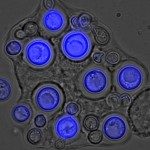Link to Pubmed [PMID] – 2073097
Antimicrob. Agents Chemother. 1990 Nov;34(11):2055-60
Cryptococcosis is an opportunistic infection that is responsible for increased morbidity and mortality in patients with the acquired immunodeficiency syndrome. The high toxicity of the antifungal agent that is mainly used against cryptococcosis, amphotericin B (AMB), accounts for the need for new treatments, especially in patients with the acquired immunodeficiency syndrome because of the high relapse rate of cryptococcosis. Drug targeting may be one of these alternate treatments. Since we have demonstrated that an immunoglobulin G1 (IgG1) anti-Cryptococcus neoformans serotype A monoclonal antibody (E1) was protective during experimental cryptococcosis in mice, we investigated whether specific targeting of AMB with liposomes that bear E1 would improve the therapeutic index of the drug. For that purpose, in vitro and in vivo experiments were designed to compare the specificities and activities of these liposomes with those of control immunoliposomes bearing a nonrelated IgG1 monoclonal antibody (CY34). The immunoliposomes were prepared by covalently linking E1 or CY34 and small unilamellar vesicles. When immunoliposomes were incubated with yeast cells, only E1-bearing liposomes recognized C. neoformans. In vivo, mice that were treated 24 h after infection with one injection of AMB (0.12 mg/kg of body weight) intercalated into E1-bearing liposomes survived significantly longer than did those given the same dose of AMB alone or AMB intercalated into nontargeted liposomes or control immunoliposomes. None of the mice that were given control treatments did statistically better than those that were given AMB. Keeping in mind that this kind of therapy requires knowledge of the antigenic type of the infecting organism, the results suggest that specific targeting of small doses of AMB improve the efficacy of AMB and might be an alternative to the use of larger doses of AMB.

